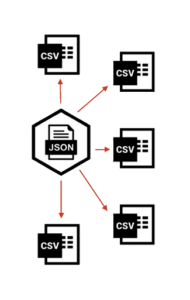
XBRL-CSV: future of bank reporting
2025 will bring a new format to European banks.
Since 2005, with the introduction of Basel II and European integration, banks have been using the XBRL format for their regulatory reporting.
Almost twenty years later, there is a new acronym which will make it easier to report large volumes of data, XBRL-CSV, which is part of XBRL’s move to OIM (Open Information Model).
This article discusses the reasons for the update to the XBRL standard, how and when it is being implemented by authorities, such as the EBA, and the implications of the new format for supervised companies.
XBRL-CSV a new name in bank reporting
For European bankers and insurers, it has become normal practice to submit regulatory reports for CRD/BRRD, such as COREP and FINREP statements, and Solvency 2 using the XBRL format. XBRL is a derivative of XML chosen in 2005 by the European Commission and the CEBS (European Committee of Banking Supervisors) and CEIOPS (European Committee of Insurance and Occupational Pensions Supervisors), now known as EBA (European Banking Authority) and EIOPA (European Insurance and Occupational Pensions Authority).
The adoption of XBRL Taxonomies, dictionaries of data points, has become almost second nature, standardizing reporting requirements and providing validation rules to facilitate pre-submission checks before sending a report to supervisors. These Taxonomies assist in identifying the necessary data to be reported, formalizing consistency rules, and thus reducing costs for firms. The XBRL format, now the standard in the European Union and beyond, is supported by numerous software vendors, offering a wide range of products and services at reasonable prices, allowing reporting managers to focus on the content rather than on the information exchange technology.
However, for larger organizations, the size of the XBRL files being submitted can be significant and is increasing, impacting both storage and bandwidth needs. The authorities’ desire for increasingly granular reporting adds to the volume of reported data. The solution lies in using a less verbose format, like CSV (comma-separated values), to compress information while retaining the benefits of standardisation, semantic structure, and data quality control provided by XBRL taxonomies.
A review of OIM
XBRL-CSV is not just a simple CSV file with comma-separated data, but actually a group of files linked to an XBRL Taxonomy that provides meaning to the data and describes the relationships between data points so that the data can be then be validated. XBRL-CSV enables the exchange of files which can be compressed to less than 10% of the volume of a standard XBRL-XML file. The diagram provides a representation of an XBRL-CSV instance and its components, as compared to an XBRL-XML instance.

XBRL-CSV emerged from a strategic review of the XBRL language, called the OIM (Open Information Model), aimed at enhancing interoperability with formats other than XML. The XBRL Standards Board (XSB), a part of XBRL International and the organization in charge of the XBRL standard, also attempted with OIM to simplify the specifications for developers and users. Older features, not used by current Taxonomies, were removed, and significant improvements were incorporated, especially for XBRL Calculations and the XBRL Formula specifications, which describe data quality rules (aggregation consistency and more complex assertions) for related data.
XBRL-CSV Implementation
Numerous software vendors have incorporated OIM specifications into their tools and offer XBRL processors certified by XBRL International. On the authorities side, the EBA started development on using the new specifications since CRR 3.1 and aims to make the XBRL-CSV submission format mandatory by the end of 2025, even though the XBRL validation specifications are still being worked upon and further development is planned with updated features and additional formats.
The work has also enabled harmonization of development systems between the EBA and EIOPA, via a joint project, the DPM Refit (recently renamed DPM 2.0) to modernize the DPM (Data Point Model) implementation and taxonomy architecture. However, differences may remain as EIOPA still needs to define the XBRL-CSV structure underpinning insurance firm reporting, and EBA’s choice to include DPM codes (datapoint_ID) in the taxonomy to identify data may not necessarily be adopted.
The new architecture, developed with the help of the Eurofiling association, will enable the future requirements to be met by DPM 2.0 and will formalize the technical definition as an additional layer to the existing XBRL specifications. The DPM methodology allows for the analysis of regulatory reporting tables to generate the Taxonomy, defining codes based on the numbering of sheets, rows, and columns to identify each cell in the required tables. Validation rules are then developed based upon these simple coordinates. Thus, users can understand the “datapoint_ID,” which links a specific data point to the regulatory reporting tables.
THE FUTURE OF BANK REGULATORY REPORTING
Discover more about the XBRL-CSV format in our past webinar where we explained the problematic, goals, and future of this format.
WEBINAR ON XBRL-CSV
Impact Analysis
For XBRL and regulatory reporting, the new OIM standard providing both XBRL-CSV and XBRL-JSON (a lightweight transmission format particularly used for publishing data) opens up possibilities for processing much larger volumes of data and simplyfying development.
This is particularly relevant in the integrated reporting approach initiated by the European Central Bank (Integrated Reporting Framework, IReF) to combine statistical and prudential reports into a central dictionary for supervision, and only requesting each piece of information once, including granular transaction data, statistics, key ratios, or aggregated indicators.
For developers, it means working with reasonable file sizes for the largest institutions and delivering acceptable performance even for data reported by transaction. For bankers, it is hoped that the current mix or reporting standards (in which a separate report and key indicators are added for each supervisory need, although calculated from a common source) will give way to the single transmission of the base data.
XBRL: a vast field of application
The open XBRL format has been used in France for fifteen years now, with the implementation of Corep, Finrep and Surfi reporting. Its high level of standardization and the possibility, for each remitter, of obtaining a validation report even before sending it to the regulator have made it possible to obtain remarkable remittance quality.
The use of XBRL goes beyond the field of Banking and Insurance reporting, with the implementation of inline XBRL reporting, combining high quality graphics and information tagging, for companies’ ESEF (European Single Electronic Format) annual reports. listed companies set up by ESMA (European Securities and Markets Authority) and the AMF (Financial Markets Authority), as well as an ESG (environmental, social and governance) reporting base proposed in Europe by EFRAG ( European Financial Advisory Group).
The modernization of the standard with the arrival of XBRL-CSV is good news for its ability to manage larger volumes of data, while retaining the features that have made the language successful. The XBRL-CSV format anchors the use of XBRL in the future without having to completely revolutionize the structures in place. French national taxonomies will also be able to benefit from this development when it is implemented and the process is validated by banking and insurance supervisors.
The community for this free format is active. Many players are constantly contributing to its development, in particular thanks to national, European and international working groups bringing together the different links in the reporting chain: users such as publishing companies or supervisory institutes. The confrontation of points of view and the collaboration capacities of each person enabled the necessary progress that was well anticipated.
Vincent Le Moal-Joubel, President of XBRL France, XBRL expert, Banque de France and Lucie Hussonnois, member of XBRL France, XML-XBRL expert, Banque de France
The authors are Thomas Verdin of Tesh-Advice and Martin DeVille of UBPartner.
The original article on which this is based was published in French in the Revue Banque, n°887-888 Janvier 2024 pp126-228 and is available online on the revue-banque.fr website. Please send comments, corrections, and any alternative ideas to info@ubpartner.com.
